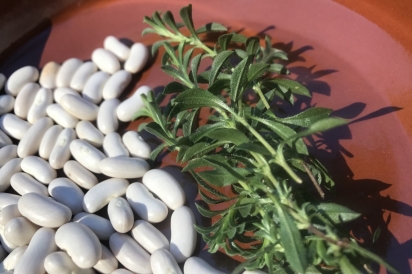Cool Beans! It's Winter.
WHAT'S FRESH?
LOCALLY PRESERVED
If you choose to make a conscious effort to support local agriculture, don't stop because it's winter! Visit a winter farmers’ market or an onsite farm store. Purchase what the agricultural industry calls a value-added product. This includes jams, pickled veggies and sauces. Farms like Green Heron Growers make truly unique items such as shiitake hazelnut pate, shiitake barley soup and mushroom tinctures. They have a farm store in Sherman, and also vend at winter markets in Fredonia and at Horsefeathers in Buffalo.
DRIED BEANS, A WINTER FRIENDLY INGREDIENT SUPERIOR WHEN LOCAL
Beans store well. In fact, some dried beans found in grocery stores could be a few years old. That’s OK if it’s all you have access to, but for superior texture and faster cooking, buy from a local small farmer who may only have this past season’s harvest. Small farmers may also choose to grow a few obscure varieties based on flavor or nutrition.
Beans are versatile, used widely in dishes such as soups, salads and hummus or other spreads. Called pulses, the edible seeds of legume plants which also include chickpeas and lentils, they are high in protein, fiber and essential minerals. They may reduce life-threatening diseases in rich nations linked to obesity, and feed the hungry in less fortunate areas of the globe. They are also an environmentally kind protein to cultivate. They add nutrients to soil, use little to no energy to store and ship and don’t create the same harmful environmental effects as large-scale meat production.
MEAN BEAN BROTH
Vegetable, meat or bone broth and stock are both everyday culinary topics and recipe ingredients. Try using different combinations of beans to make a mean bean broth. When cooking dried beans, the leftover water you use could be the start of tomorrow's soup, stew or sauce. Use the broth to poach or steam other ingredients. Add herbs, root vegetables, bones or even the shells of your favorite crustacean.
HERBS THAT JIBE WITH BEANS
Traditional herb and food combinations happen for a few basic reasons. First and foremost is how well the resulting flavor is cherished by the masses. Or often, it's due to a simple adage that winemakers, sommeliers and chefs like Adam Goetz of CRāVing in Buffalo like to remind us of: "what grows together, goes together.” This could refer to grape varietals that grow well in the same terroir and make a fine wine blend, or classic salsa ingredients harvested at the same time of year. Historically, ingredients came together because of availability in regions of the world during certain periods.
One more factor affecting how ingredients come to find each other in the same recipe involves the medicinal effect of an herb. Here are two examples of herbs that accompany beans for both flavor and function.
WINTER SAVORY (Satureja montana)
A hardy perennial that you can find dried or maybe even green this time of year is winter savory. It is the stronger, more peppery cousin to summer savory, which is an annual. The name may be unfamiliar, but it is often found in Italian herb blends and a popular French blend, Herbes de Provence.
Savory plays a rockstar role in the classic dish, Mediterranean white beans with savory and garlic. Originating in southern Europe and northern Africa, the herb is a natural pest management solution, and a companion plant to a bean plant. Savory is said to repel bean weevils, a type of beetle. Medicinally it helps with digestion and may ease the bodily function that is usually associated with beans.
Winter savory has also been planted near beehives since the time of the Romans. It's said that the Romans liked their food sweet and savory—meaning non-sweet as well as dishes flavored with the actual herb. Savory can season a dish without the need for much salt and pepper. Also, savory plants both attract honeybees and are believed to add flavor to honey they make. Coincidence or not, another medicinal use of this herb is to relieve pain and itching caused by insects and especially bees.
EPAZOTE (Dysphania ambrosioides)
The common name for the herb epazote is a Spanish variation of the Aztec, or Nahuatl, word, epazōtl, which means skunk sweat. Epazote is very pungent when fresh. There are some people who grow the herb in Western New York as an annual, but one can find it dried in any Latin grocer or section in the grocery store. Pregnant or nursing women should avoid the herb, and the seeds and oil from the plant are poisonous to all.
Being native to Central America, South America and Mexico, it’s no surprise that epazote is a common ingredient in a typical bean dish from this region of the world, refried beans. It pairs well with black and pinto beans, often used for the dish. Once again, it’s valued for both flavor and its supposed carminative properties. Like savory, it can ease an upset stomach and reduce flatulence.







